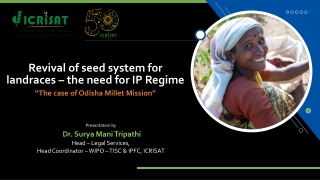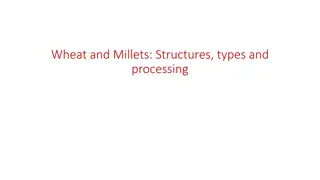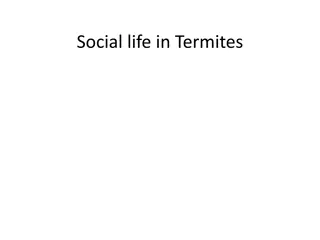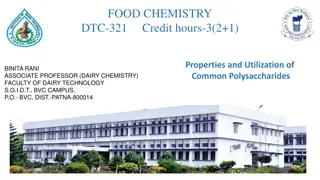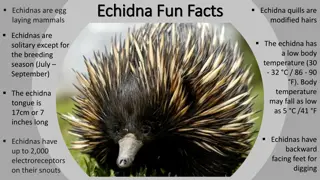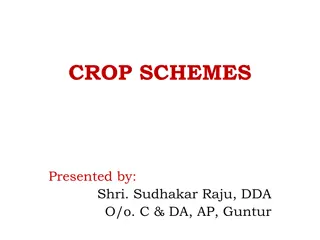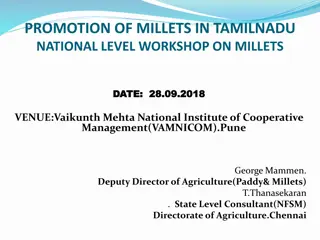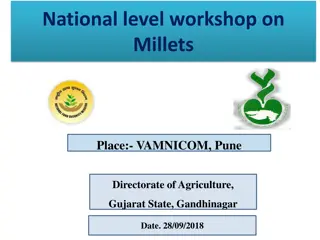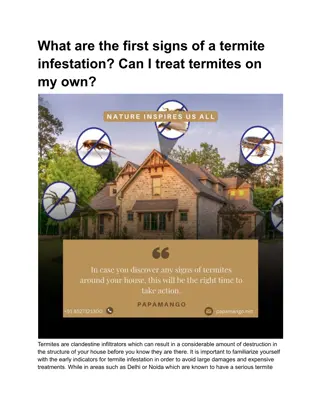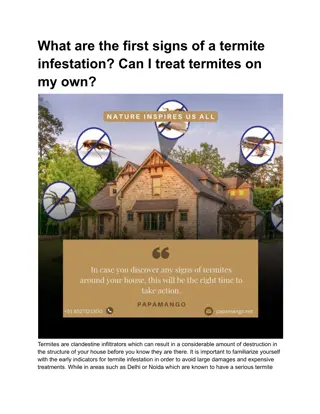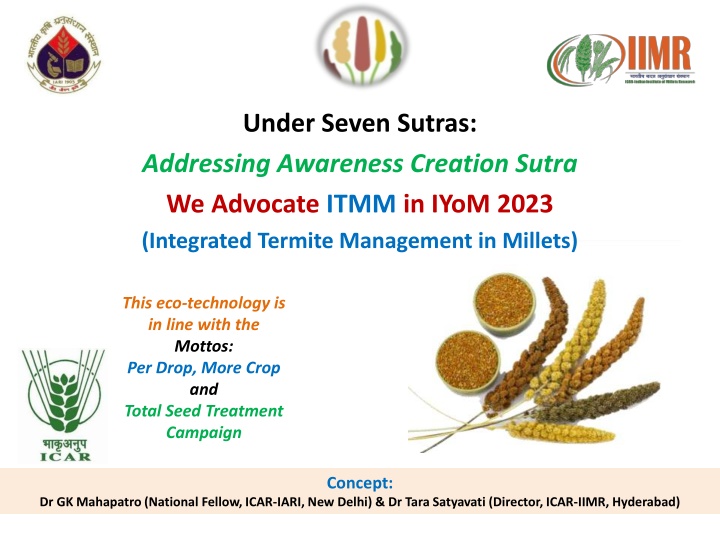
Innovative Eco-Technology for Termite Management in Millets
Discover the Integrated Termite Management in Millets (ITMM) initiative for 2023, focusing on innovative eco-technology to enhance crop yields. Learn about effective strategies to manage termites in pearl millet and sorghum crops, spearheaded by Dr. GK Mahapatro and Dr. Tara Satyavati. Explore the practical applications, including seed treatments and field management practices for sustainable agriculture.
Download Presentation

Please find below an Image/Link to download the presentation.
The content on the website is provided AS IS for your information and personal use only. It may not be sold, licensed, or shared on other websites without obtaining consent from the author. If you encounter any issues during the download, it is possible that the publisher has removed the file from their server.
You are allowed to download the files provided on this website for personal or commercial use, subject to the condition that they are used lawfully. All files are the property of their respective owners.
The content on the website is provided AS IS for your information and personal use only. It may not be sold, licensed, or shared on other websites without obtaining consent from the author.
E N D
Presentation Transcript
Under Seven Sutras: Addressing Awareness Creation Sutra We Advocate ITMM in IYoM 2023 (Integrated Termite Management in Millets) This eco-technology is in line with the Mottos: Per Drop, More Crop and Total Seed Treatment Campaign Concept: Dr GK Mahapatro (National Fellow, ICAR-IARI, New Delhi) & Dr Tara Satyavati (Director, ICAR-IIMR, Hyderabad)
Managing Termites in Millets (Sri Anna) Termites (Odontotermes obesus, O. microdentatus and Microtermes obesi, M. unicolor) are reported to feed on sorghum and pearl millets. However, they are not serious major pests. Follow in general the control practices as in case of wheat to tackle termites - like soil treatment and care of crop-border areas to make them mound free. Eliminate the mound if any. Pearl Millet Commonly called as Bajra, is a major cereal crop in India, supporting food requirement of a large number of people, mostly in dry belts of the country. In Rajasthan, this crop is found severely affected by the termite species Microtermes obesi. Management: Seed treatment to be done. If seed treatment has not been done and termite infestation is already present in field, in that case during first irrigation, 3-5 liters of chlorpyriphos 20% EC admixed with 50 kg of dry soil may be spread per hector in field and then irrigation can be done.
Sorghum Commonly known as sorghum, is a major cereal crop in India, supporting livelihood of a large number of people. Termite attack has been reported from various places in India. In the western part of the country, specially in Punjab and Rajasthan, Odontotermes obesus has been reported to cause massive loss. Plants with height less than 15 cm, are found to be more prone to attack by termites. Management Seed treatment to be done. If seed treatment has not been done and termite infestation is already present in field, in that case during first irrigation, 3-5 liters of chlorpyriphos 20% EC admixed with 50 kg of dry soil may be spread per hector in field and then irrigation can be done. Pusa Push-Pull strategy (3P4C) 4C Carbon, Climate, Conservation, Cash Smart Progressive farmers are encouraged to test this eco-technology, which is a fusion of Indigenous and Frontier sciences/technologies a new norm of Swatch Kheti. This is applicable when farmer goes for Millet Wheat cropping system. Innovated an eco-technology for termite management in wheat-maize agro- ecosystem, i.e. attained with crop residues (pull-site, maize stubbles) and main/target crop (push-site, wheat-rows). The technology was validated, successfully demonstrated to the farmers at Agro-technology Transfer Information Centre, IARI, New Delhi. 3P4C can lead to the End-Of-Pipe (EOP) technique in effective biopesticides in termite control. Interested farmers may contact us for taking this technology for millet wheat system.
Replace Maize with Millets, 1-3 lines of Wheat are taken as per the spacing in Millets.
Seed Treatment for Rainfed Millet Cultivation (Seed Hardening) Providing Seed Treatment packages Compatibility Chart - Insecticides, bio-fungicide & bio-fertilizers Recommendation based on in vitro investigation Dose (ml/kg seeds) +Biofertiliser Target-crop Insecticide Specific remark (if any) Insecticide alone Insecticide +Biofungicide + Biofertiliser 3 4 2 C C NC C C NC Imidacloprid Fipronil Chlorpyriphos Phytotonic -- Phytotoxic Wheat 3 5 C C C C Imidacloprid Fipronil Chlorpyriphos Phytotonic -- Maize Not recommended Phytotoxic Test bio-fungicide @ 4g/kg seeds, Trichoderma harzianum Lab culture (Division of Plant Pathology, IARI.) Crop-specific biofertilisers @ 25 g/kg seeds (wheat Azotobacter; maize Azospirillum) Seed hardening Treatment in rainfed Millets (TNAU Agritech Portal) Crop Chemical and Concentration Soaking duration (h) Maize, Tenai and Samai Pearl Millet Sorghum Ragi Benefits Higher germination Vigourous seedlings Uniform seedling growth Better seed set Benefit cost ratio:1.5:1 2% potassium dihydrogen phosphate 8 2% potassium chloride 2% potassium dihydrogen phosphate 0.5% calcium chloride 16 6 6
Millet Seed treatment with chlorpyriphos 20EC @ 4.5ml/kg seeds offers an effective control. For preventing termite damage, treat the seeds with chlorpyriphos using 90 ml a.i., respectively with 5 litres of water and spray over one quintal seed spread on floor and frequently turn to ensure proper treatment. Seed treatment with imidacloprid 17.8% SL @ 0.6 g a.i./kg (=3ml/kg seed), or Fipronil (Regent 5FS @ 0.3 g a.i./k, =6ml/kg seed) is also very effective. In case preventive seed treatment against termites could not be taken, mix 0.8 litre chlorpyriphos with 50 kg soil and broadcast in one hectare field followed by light irrigation if feasible. In water scarce area, where the pest is of regular occurrence the soil should be mixed with chlorpyriphos 5 D @ 35 kg/ha at the time of sowing. Treating Ragi/ finger millet seeds with equal amount of termite mound soil is an ITK in Odisha (Lamtaput block, Koraput district). Seed hardening is done as additional integrated approach in rainfed millets. For seed dressing earthen pots or polythene bags are used.


